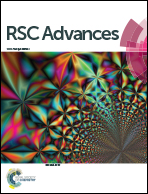Decoration of Si-nanowires-grafted Si micropillar array with Ag nanoparticles for photoelectrocatalytic dechlorination of 4-chlorophenol
Abstract
Use of Si materials as photoelectrodes in aqueous solutions is fundamentally required to inhibit the formation of an insulating SiO2 layer as well as promote the transfer of photogenerated holes and electrons from the interior of Si to the solid–liquid interface. In order to meet these requirements, an Si material, with hierarchical structure and Si nanowires standing on the surface of Si micropillar array (SiNW/SiMP), was prepared for facilitating the transfer of photogenerated carriers to the solid–liquid interface. Decoration of SiNW/SiMP by Ag nanoparticles (Ag/SiNW/SiMP) via depositing Ag nanoparticles on the surface of SiNW/SiMP successfully restrained the generation of SiO2 through preventing the contact of SiNW/SiMP with water. Pristine SiNW/SiMP photocathode exhibited enhanced photoelectrochemical activity with a photocurrent of approximately −31 mA cm−2 at −1 V (vs. SCE), which was about one order of magnitude larger than that of SiMP; however, the photocurrent decayed with prolonged illumination. By comparison, Ag/SiNW/SiMP photocathode exhibited stable photocurrent of approximately −37.5 mA cm−2 at −1 V (vs. SCE) during 10 cycles of CV testing, which was 21% higher than that of the pristine SiNW/SiMP. Ag/SiNW/SiMP photocathode exhibited excellent photoelectrocatalytic activity towards dechlorination of 4-chlorophenol (4-CP). Over 95% of 4-CP (initial concentration of 10 mg L−1) was rapidly degradaded after 20 min, which were 3 and 1.1 times higher than those of the SiMP and SiNW/SiMP. The good reproducibility was verified by the results of six consecutive experiments.


 Please wait while we load your content...
Please wait while we load your content...